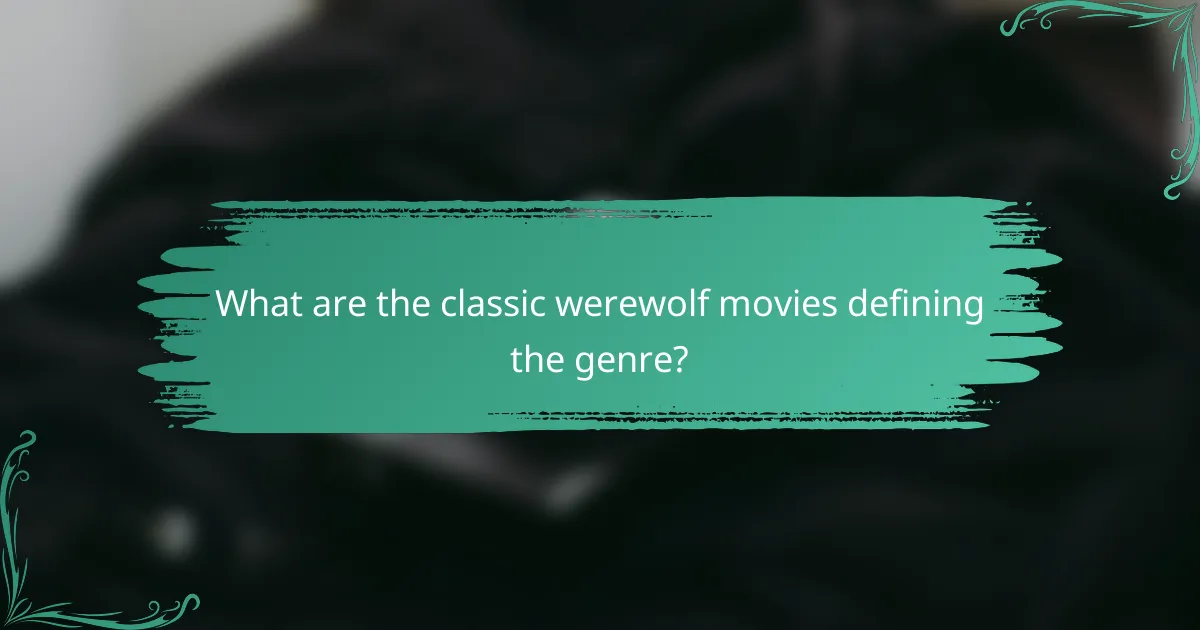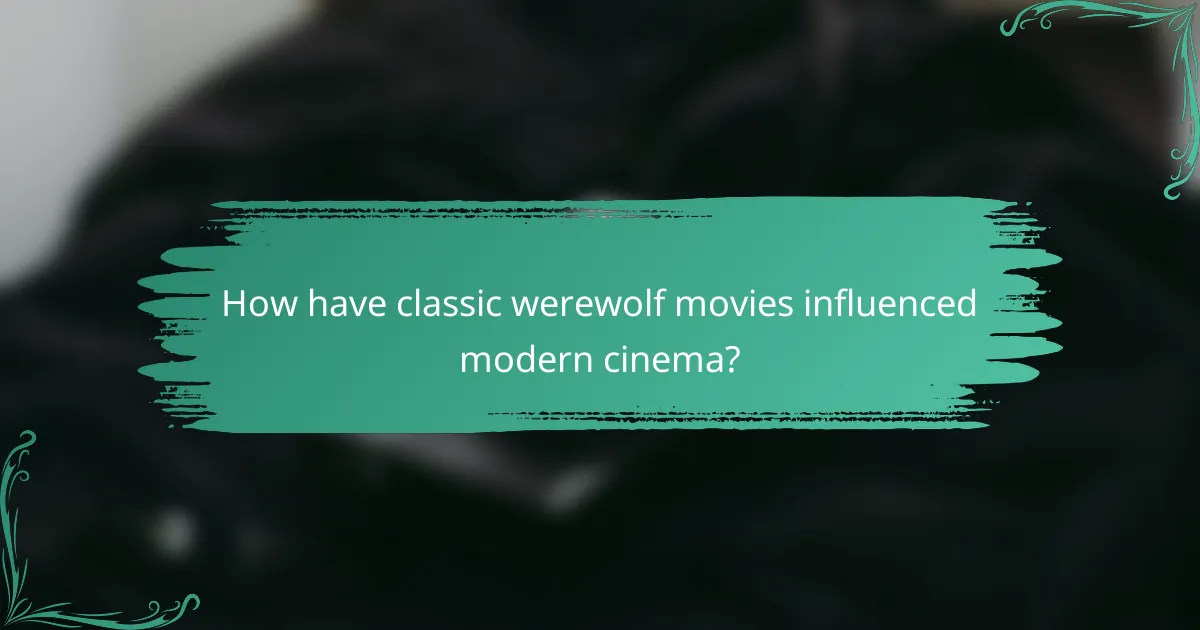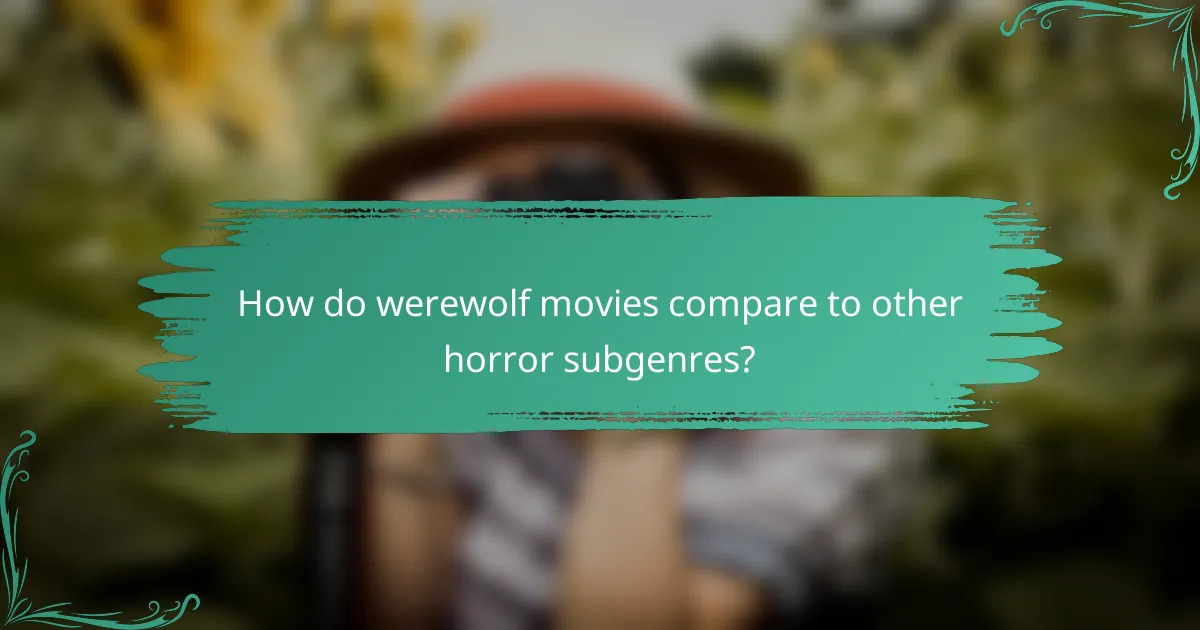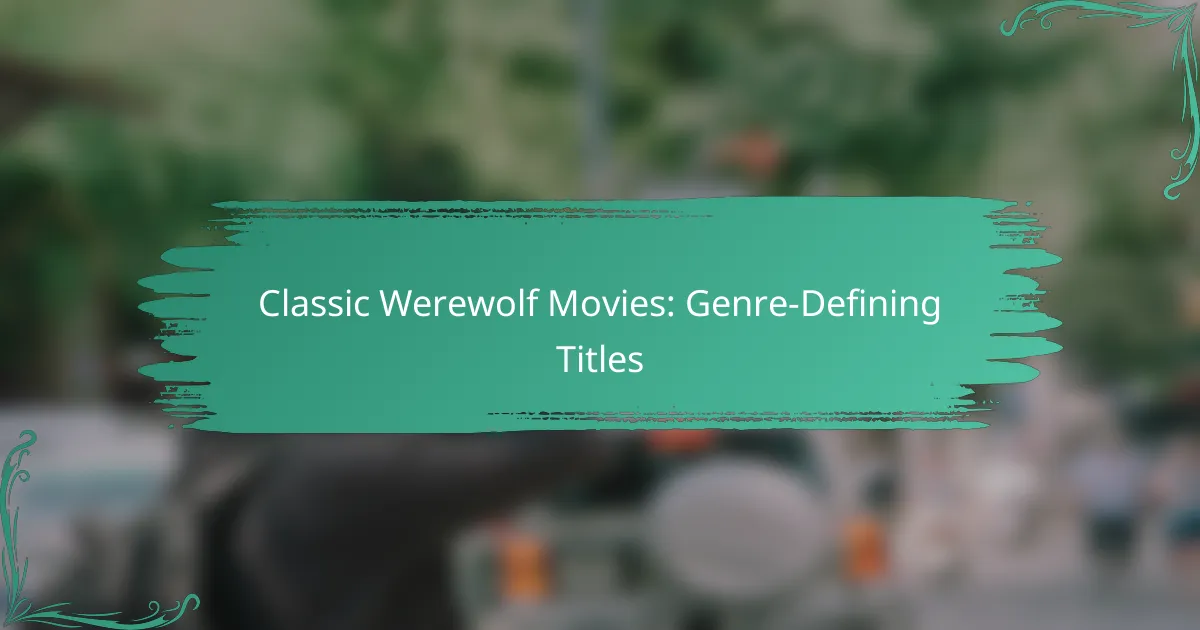Classic werewolf movies are essential to the horror genre, intertwining folklore with deep psychological themes. They delve into the complexities of transformation and identity, showcasing the eternal struggle between humanity and primal instincts. These films have laid the groundwork for modern horror, influencing storytelling, character archetypes, and the portrayal of monstrous transformations.

What are the classic werewolf movies defining the genre?
Classic werewolf movies are pivotal in shaping the horror genre, often blending folklore with psychological elements. These films typically explore themes of transformation, identity, and the struggle between humanity and primal instincts.
The Wolf Man (1941)
The Wolf Man is a cornerstone of werewolf cinema, introducing audiences to the tragic character of Larry Talbot, who becomes a werewolf after being bitten. This film established many conventions of the genre, including the full moon as a trigger for transformation and the idea of a curse.
Its atmospheric black-and-white cinematography and haunting score contribute to its lasting impact. The Wolf Man’s influence can be seen in numerous subsequent films, making it essential viewing for horror enthusiasts.
American Werewolf in London (1981)
American Werewolf in London is renowned for its groundbreaking special effects and dark humor. The film follows two American backpackers who encounter a werewolf while traveling in England, leading to a transformation that is both horrifying and tragic.
Its transformation scene is often cited as one of the best in film history, showcasing innovative practical effects. The blend of comedy and horror sets it apart, influencing future films in the genre.
Dog Soldiers (2002)
Dog Soldiers combines military action with horror, featuring a group of soldiers who encounter a pack of werewolves during a training exercise in the Scottish Highlands. The film is notable for its intense action sequences and practical effects, creating a visceral experience.
This title reinvigorated the werewolf genre with its unique setting and character dynamics, emphasizing survival against overwhelming odds. Its cult status highlights the appeal of blending genres effectively.
Ginger Snaps (2000)
Ginger Snaps offers a fresh take on the werewolf mythos, focusing on the transformation of a teenage girl, Ginger, as she grapples with her identity and burgeoning sexuality. The film cleverly uses the werewolf metaphor to explore themes of adolescence and female empowerment.
Its unique perspective and strong character development make it a standout in the genre, appealing to both horror fans and those interested in deeper narratives.
Silver Bullet (1985)
Silver Bullet is based on a Stephen King novella and tells the story of a small town plagued by a series of brutal murders attributed to a werewolf. The film features a young boy in a wheelchair who, with the help of his sister, uncovers the truth behind the killings.
Its blend of supernatural elements with a coming-of-age story provides a different angle on the werewolf theme, emphasizing family and community. The film remains a nostalgic favorite for many horror fans.

How have classic werewolf movies influenced modern cinema?
Classic werewolf movies have significantly shaped modern cinema by establishing key horror tropes and character archetypes that continue to resonate today. Their influence is evident in contemporary storytelling, special effects, and the portrayal of monstrous transformations.
Impact on horror genre
The werewolf genre has played a crucial role in defining horror films, introducing themes of duality and the struggle between humanity and primal instincts. Classic titles like “The Wolf Man” set a precedent for horror narratives that explore the darker aspects of human nature, influencing countless filmmakers.
Modern horror often revisits these themes, utilizing the werewolf mythos to create tension and fear. Films such as “An American Werewolf in London” blend horror with dark humor, showcasing how classic werewolf movies have encouraged genre experimentation.
Evolution of special effects
Classic werewolf films pioneered special effects techniques that have evolved into today’s advanced CGI and practical effects. The transformation scenes in movies like “The Howling” showcased innovative makeup and animatronics, setting a high standard for visual storytelling.
These early effects have inspired modern filmmakers to push the boundaries of creativity. Today, while CGI dominates, the principles established by classic films remain relevant, emphasizing the importance of physicality in monster transformations.
Character archetypes in film
Classic werewolf movies introduced enduring character archetypes, such as the tragic monster and the reluctant hero. These archetypes have become staples in modern storytelling, allowing filmmakers to explore complex emotional narratives surrounding identity and morality.
For example, the conflicted nature of the werewolf has influenced characters in various genres, from horror to fantasy. This archetype encourages audiences to empathize with the monster, reflecting broader themes of acceptance and the human condition.

What themes are prevalent in classic werewolf films?
Classic werewolf films often explore themes of transformation, isolation, and the conflict between nature and nurture. These elements contribute to the genre’s depth, reflecting human fears and societal issues through the lens of lycanthropy.
Transformation and identity
Transformation is a central theme in werewolf films, symbolizing the struggle between one’s human identity and primal instincts. Characters often undergo physical and psychological changes that challenge their sense of self, leading to a crisis of identity. This duality can resonate with viewers, highlighting the complexities of human nature.
For example, in films like “The Wolf Man,” the protagonist grapples with the terrifying reality of becoming a creature of the night, which serves as a metaphor for personal demons and societal pressures. This theme invites audiences to reflect on their own transformations and the darker aspects of their identities.
Isolation and societal fear
Isolation is another prevalent theme in classic werewolf films, often depicted through characters who are shunned or misunderstood by society. This sense of alienation amplifies the horror, as the werewolf becomes a symbol of the fears that society holds toward the unknown or the different. The fear of being an outcast can be a powerful motivator for characters’ actions.
In many narratives, the werewolf’s transformation leads to a physical and emotional separation from loved ones, emphasizing the loneliness that accompanies such a drastic change. This theme resonates with audiences, as it reflects real-life experiences of isolation and the fear of societal rejection.
Nature vs. nurture
The conflict of nature versus nurture is a significant theme in werewolf films, examining whether one’s behavior is determined by inherent traits or external influences. Characters often face the dilemma of their animalistic instincts versus their moral upbringing, raising questions about free will and responsibility.
Films like “An American Werewolf in London” illustrate this struggle, as the protagonist battles his newfound urges while trying to maintain his humanity. This theme challenges viewers to consider how much of their identity is shaped by their environment versus their innate nature, making it a thought-provoking aspect of the genre.

Which werewolf movies are considered cult classics?
Cult classic werewolf movies often blend horror with unique storytelling, gaining a dedicated following over time. Titles like “WolfCop,” “Howl,” and “Late Phases” exemplify the genre’s appeal through their innovative takes on werewolf lore and engaging narratives.
WolfCop (2014)
The story follows Lou Garou, a disgraced officer who, after a bizarre transformation, takes on crime in a unique way. Its blend of absurdity and horror has earned it a special place in cult cinema.
Howl (2015)
This film focuses on survival and the dynamics between characters as they face the supernatural threat. Its unique premise and strong performances contribute to its cult status among werewolf movie fans.
Late Phases (2014)

What are the key characteristics of werewolf films?
Werewolf films typically feature themes of transformation, the influence of the full moon, and the struggle between human and wolf instincts. These elements create a compelling narrative that explores the duality of human nature and the horror of losing control.
Transformation sequences
Transformation sequences are a hallmark of werewolf films, showcasing the physical and emotional change from human to wolf. These scenes often involve dramatic visual effects, emphasizing the pain and horror of the metamorphosis. Classic examples include the slow, agonizing changes seen in films like “An American Werewolf in London,” where the transformation is both visceral and captivating.
Effective transformation sequences can evoke empathy and fear, making the audience feel the character’s struggle. Filmmakers often use practical effects, CGI, or a combination of both to create these memorable moments.
Full moon mythology
The full moon is a central element in werewolf mythology, often serving as the trigger for transformation. Many films adhere to this tradition, portraying the full moon as a time of danger and unpredictability. This connection to lunar cycles adds a layer of suspense, as characters must navigate their transformations under the watchful eye of the moon.
In various cultural interpretations, the full moon symbolizes madness and primal instincts, reinforcing the theme of losing one’s humanity. This aspect can be a powerful storytelling device, heightening tension and anticipation throughout the film.
Human-wolf duality
The theme of human-wolf duality explores the conflict between civilized behavior and primal instincts. Characters often struggle with their dual nature, leading to internal and external conflicts that drive the narrative. This duality can manifest in moral dilemmas, where the character must choose between their human values and their animalistic urges.
Films like “The Howling” and “Ginger Snaps” delve into this theme, illustrating how the werewolf curse can serve as a metaphor for adolescence, identity, and the darker sides of human nature. This exploration invites viewers to reflect on their own instincts and societal norms.

How do werewolf movies compare to other horror subgenres?
Werewolf movies stand out in the horror genre due to their unique blend of folklore, transformation, and psychological themes. Unlike other horror subgenres that may rely heavily on supernatural elements or slasher tropes, werewolf films often explore the duality of human nature and the struggle between civilization and primal instincts.
Key Themes in Werewolf Movies
Common themes in werewolf movies include the loss of control, the fear of the unknown, and the conflict between humanity and animalistic urges. These films often depict characters grappling with their transformations, representing inner turmoil and societal rejection. The werewolf serves as a metaphor for the darker aspects of human nature, making these films resonate on a psychological level.
Notable Examples of Classic Werewolf Films
Classic werewolf films such as “The Wolf Man” and “An American Werewolf in London” have defined the genre and set standards for storytelling and special effects. “The Wolf Man” introduced iconic elements like the full moon transformation, while “An American Werewolf in London” combined horror with dark humor and groundbreaking makeup effects. These films have influenced countless others and remain benchmarks for quality in the genre.
Comparative Analysis with Other Horror Subgenres
When comparing werewolf movies to other horror subgenres, such as zombie or slasher films, the focus on transformation and character development is more pronounced in werewolf narratives. Zombie films often emphasize survival and societal collapse, while slasher films prioritize suspense and the thrill of the chase. Werewolf movies uniquely balance horror with emotional depth, making them distinct within the broader horror landscape.
